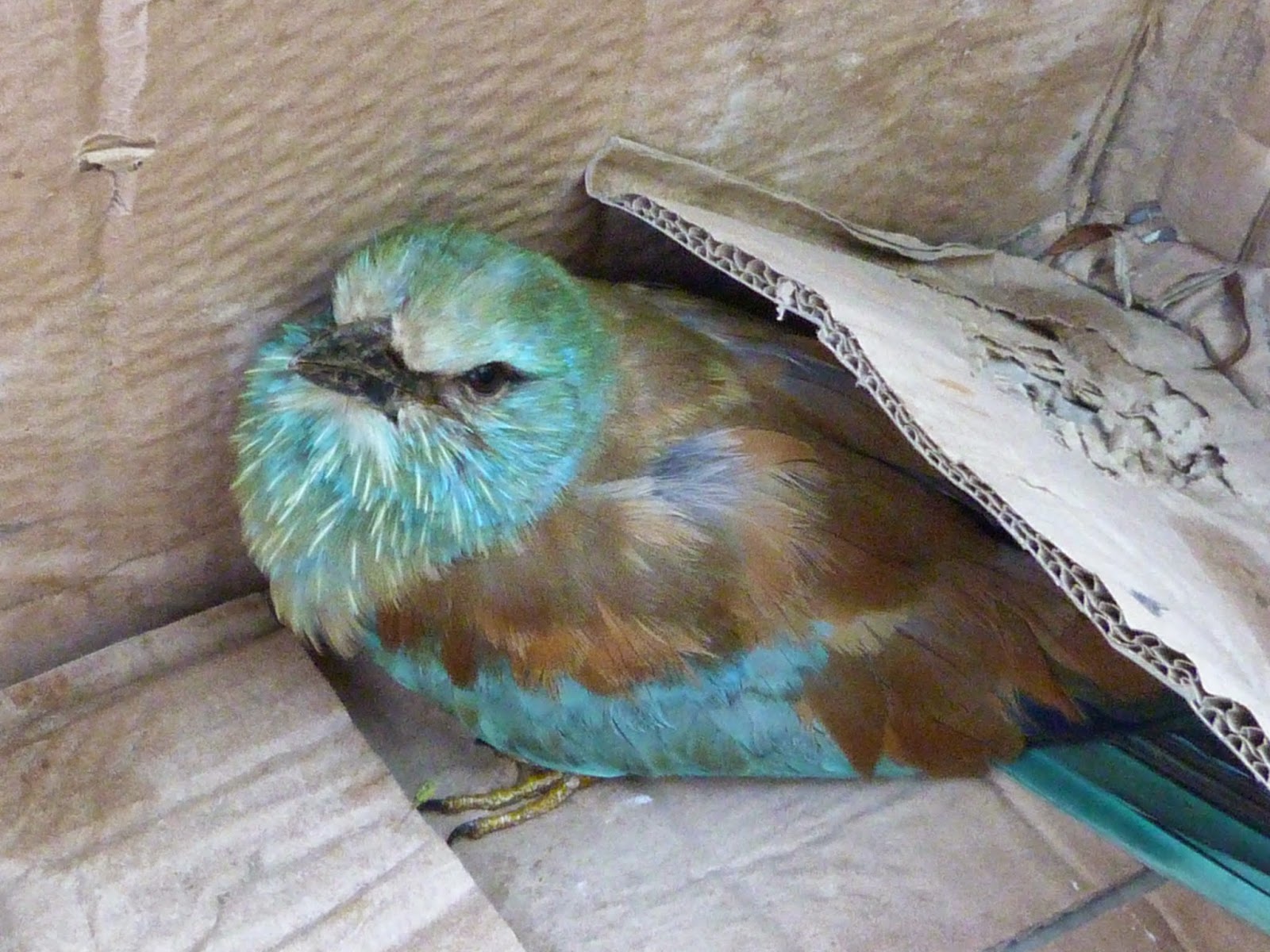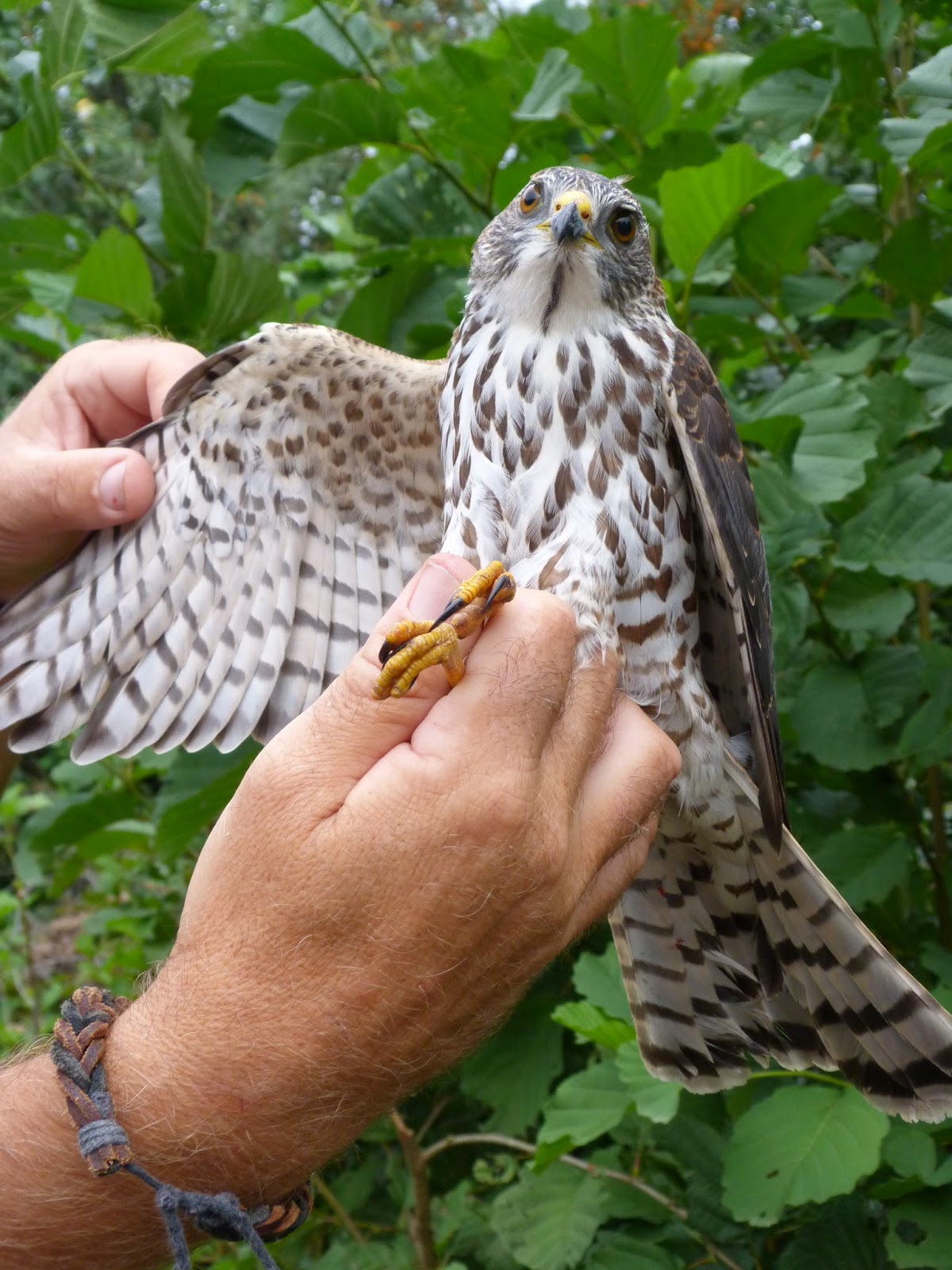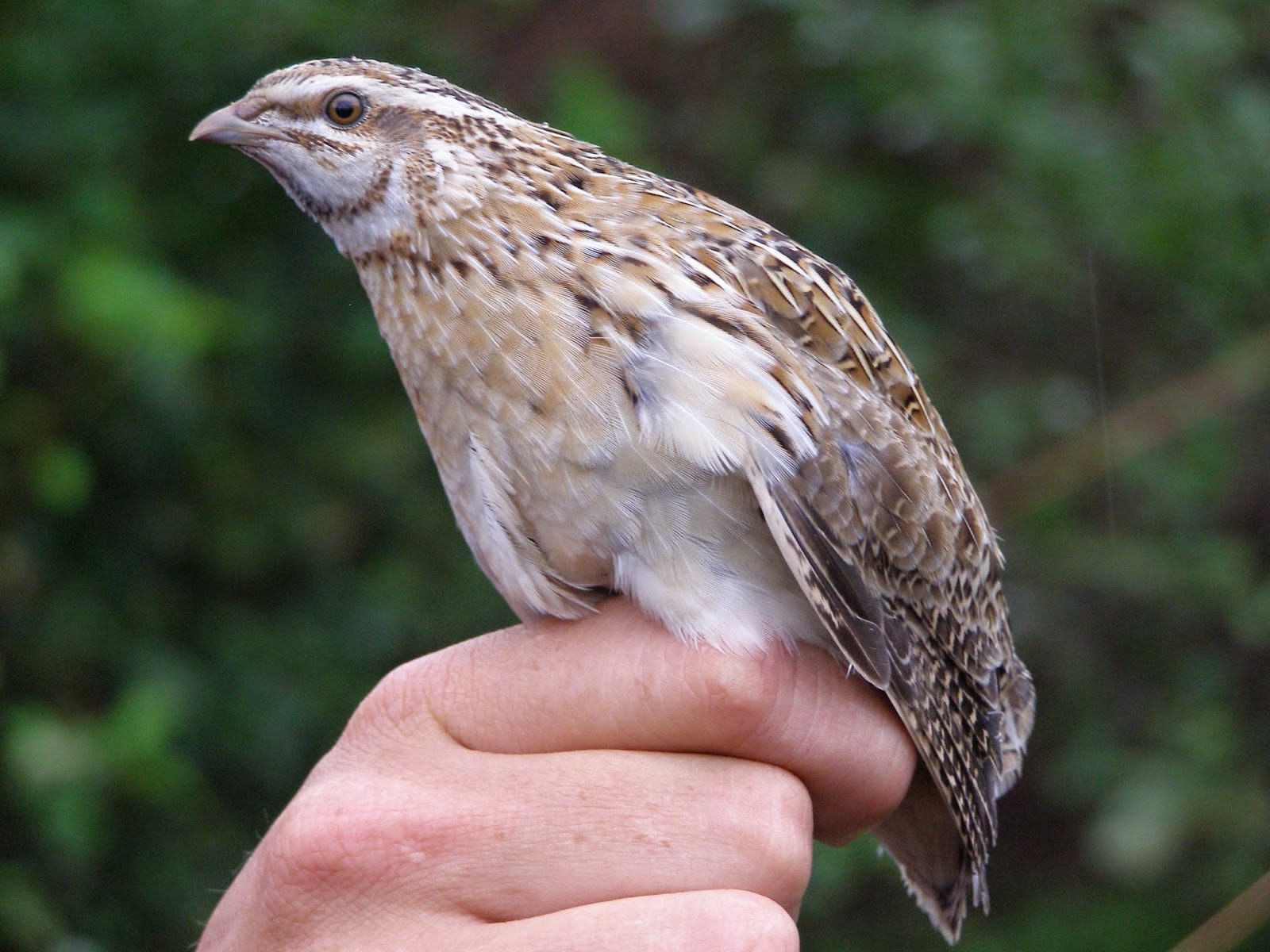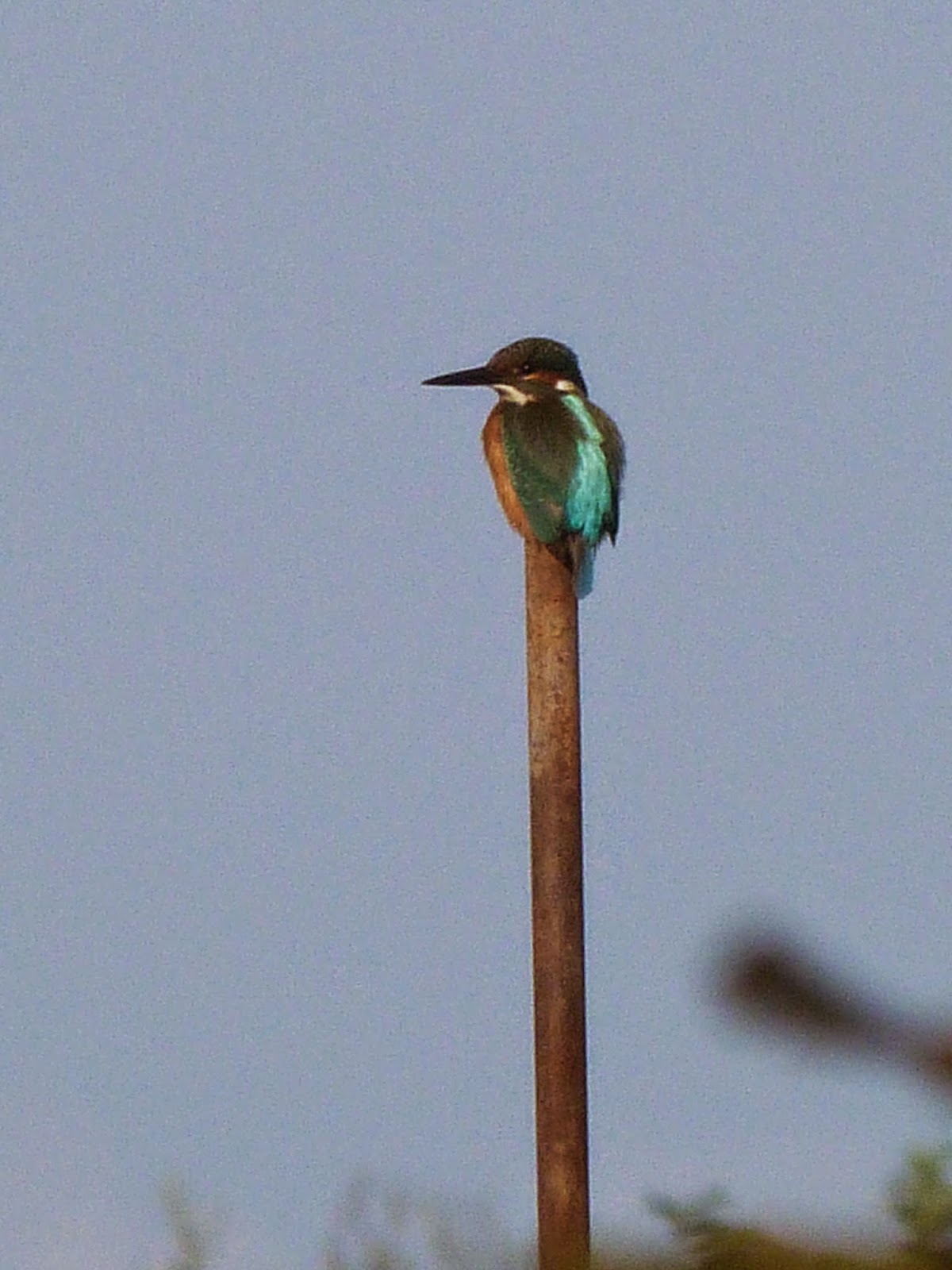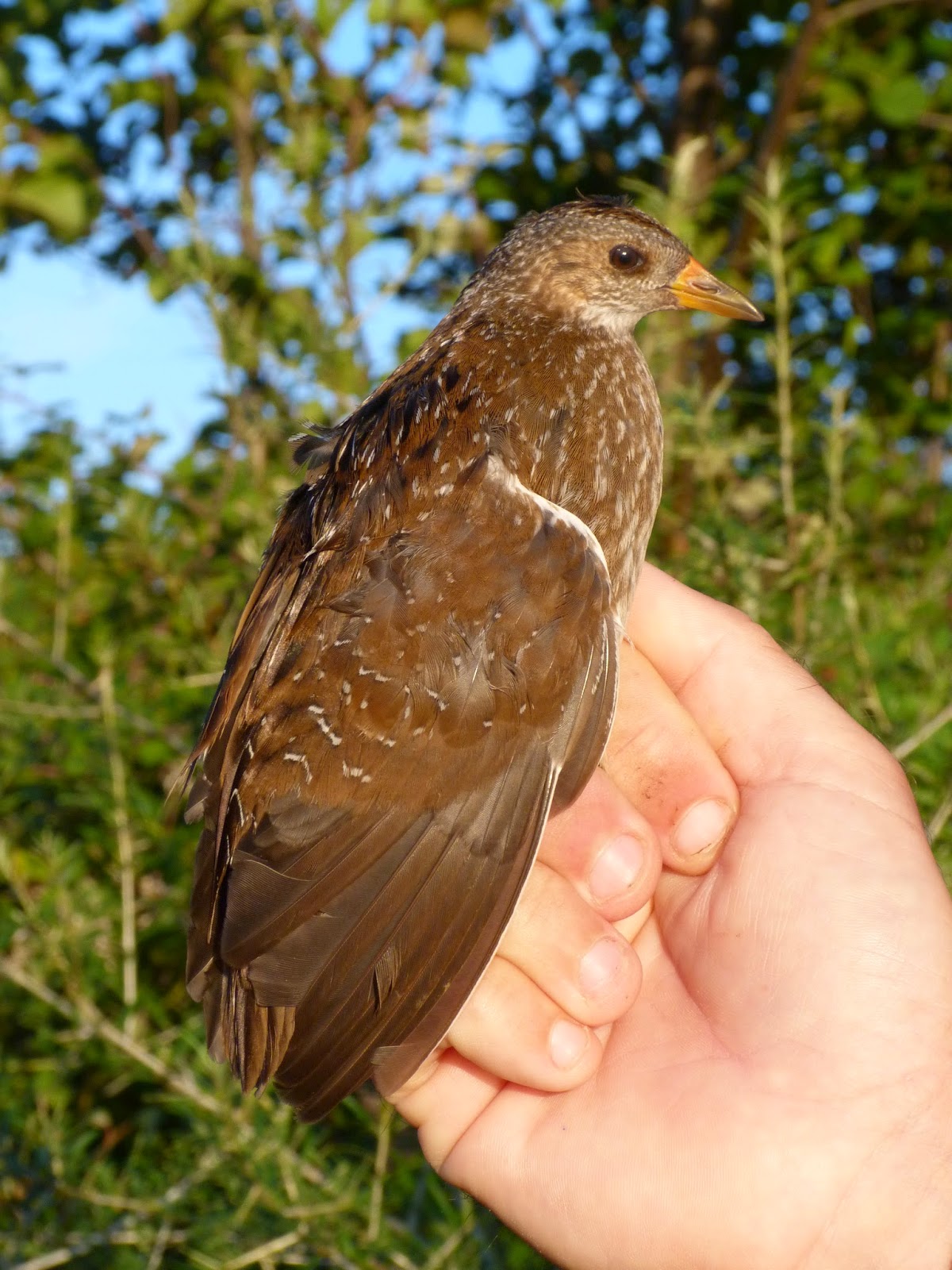We arrived at Batumi, Georgia on the 9th of September, planning to settle in for a few days before taking over from the Belgium team who had been on site since mid August. We spent time at the ringing camp in order to familiarise ourselves with some of the expected species, understand potential difficulties - hunters and cows included - and to get to know the local area.
Although our camp organiser arrived a couple of days after us we made good use of our time, seeing how the Belgians managed high volume days, manned the site 24 hours a day and handling some of the ringed birds.
River Warbler
Red-breasted Flycatcher
Blyth's Reed Warbler
We also came across the sad results of hunting. Many hunters shoot at everything as well as the official species of Turtle Dove, Quail, Crakes and Ducks.
Great White Egret
Marsh Harriers are shot, the wings cut off and the carcass taken for food. It was made clear that hunters were not to be challenged, a rule of the Batumi Raptor Count organisation, as this may damage the efforts to change the hunting traditions via other means.
The Belgian team compare European Bee-eaters.
We were also able to find ourselves more suitable accommodation going from this, where 6 lodgers shared one toilet and shower with a family of 10.............
........to a bungelow with twin bedded rooms, each with its own toilet and shower. I couldn't imagine 30 days in a room with no storage or place to sit down and where we had to access the bathroom through the other communal bedroom. Zouri and Zaira, our new hosts were very hospitable and brought us traditional Georgia food to seal the deal. We did our best to explain our reason for being in the Chorokhi Delta, achieved mainly by MH who spoke some Russian, and Zouri brought out his gun to show us what he hunts with. We showed some of our photographs of captured birds and it became clear that he hunted only the allowed species. One of his sons hunts geese and the other does not hunt at all.
Our room in what became the ringers' bungelow.
There was also time to watch raptors overhead.
Short-toed Eagle
On the 13th came the official hand over. We took over at 14.00 and these were the first three birds out of the nets. Being a pm hand over, our first afternoon, as it was most days, was relatively quiet, with only 21 birds processed.
I started off with a Thrush Nightingale from our first round. I was also handed a Hoopoe, Hop in Dutch, that turned out to be the only one caught.
Hoopoe
The next day, the 14th we started at 05.30 keeping the nets open until 19.00 - which brought several extra species from the previous day, Chris processing his first Water Rail and there were more Redstart and a Bluethroat, but it was not an especially hectic day with 220 birds processed, of which 135 of these came from the evening Hirundine roost.
Water Rail
Adult male and juvenile Redstart
Bluethroat
That evening there were thousands of Swallows around roosting time.
Hirundines preparing to roost
On the 15th we again opened at 05.30 with the nest staying open until 20.00. There were quite a few hunters around. The first bird of the day was a Spotted Crake that I ran and extracted from the net, a first for MH. There was also a Baillon's Crake for MV.
Spotted Crake
Baillon's Crake
Some birdwatchers reported a live Roller floundering in the river and WH waded in to rescue the bird that was in very poor condition, even if there appeared to be no wounds. WH and GT decided to try feeding it and it took grasshoppers with no problem. We all knew the most likely outcome given its condition but little hope seemed better than just letting it die and feeding continued.
After rallying at first the Roller failed to thrive and didn't survive to be released.
The afternoon brought a capture of Bee-eaters then another large roost catch included the first Red-rumped Swallow ringed in Georgia and possibly the seventh record of the species (awaiting verification). In all 505 birds were processed, with 357 coming from the roost again.
Red-rumped Swallow
European Bee-eater
Soon it was expected that the reedbed nets may become unuseable as a forecast of severe rain expected 80mm in one day followed by 40mm the next. So some more nets went up at additional locations on the 16th and a small Wagtail roost was taken at the end of the day. There were some problems with cows getting into the net rides - several lower panels received damage. The day's total was around with X birds processed, with only 34 Hirundines and 18 flava Wagtails. A small team decided to stay overnight, resulting in the nets being left over night and open for 24 hrs over the next three days. 152 birds were processed.
Browsing cows too close to nets inevitably mean gapping holes!
There was a big change on the next day, the 17th, as Scops Owl, Little Bittern and Nightjar were caught over night and in the early morning, together with 13 Water Rails. The day was slightly busier than the previous days with 601 birds processed, though, again, 415 were from the Hirundine roost.
Scops Owl
Nightjar
Little Bittern
There was an influx of Red-backed Shrike and Red-breasted Flycatcher and a Levant's Sparrowhawk for MH.
Red-backed Shrike
Red-breasted Flycatcher
Levant's Sparrowhawk
MH with the Levant's on his last day
The 18th was the first real fall day. Suddenly there were Acros coming from the marsh nets, including Marsh Warblers carrying a lot of fat. There were 50 Water Rails caught overnight, together with Little and Spotted Crakes, a Barn Owl, and some Blyth's Reed Warblers and the first Booted Warbler was caught today. CL ringed a Blyth's and DKL did Scops and Barred Warbler.
Barred Warbler
CL, MV, TH, WH and RH with six Scops Owls
Booted Warbler
There was visual migration too with large flocks of Black-winged Pratincoles going through overhead with a range of raptors. It began to rain with moderate rain during the early evening and a roost was not possible, although the rain ceased after dark and the nest remained open until the following morning. 365 birds were processed, with only 13 Hirundines in this total, though there were 56 Crakes/Rails.
AVA, NE and GT at the ringing table
The 19th saw 205 birds captured, with again no roost being done. There were two particular low points on this day, the first when a shot Marsh Harrier was found and had to be put out of its misery and the second when a nearby shot rang out and lead shot showered down into bushes just a matter of feet from where we were sitting.
An unusual capture from the crake trap - Southern
White-breasted Hedgehog
It rained a great deal after dark with lightning all night. We started at 6.30am with heavy cloud and Wheatear was amongst the first birds from the nets. A huge group came to watch the ringing, bringing food, Georgian wine and Chacha - all for consumption before 8am. It came on to rain very heavily and the whole group took refuge in the tents. Nets were closed from 8.30am to 1.30pm. After a brief spell rain began again and continued all night, so the nets were closed quickly again, and only 81 birds were processed.
On the 21st the water was rising fast and streams running through the site.
The pool that had been quite shallow on our arrival soon rose and flowed into the area with our net rides.
Water was running through the campsite and the tent soon started to flood so everything that might spoil or be ruined was raised onto chairs or tables.
We were very concerned about the Chorokhi River that flowed just behind the campsite. It was close to bursting its banks and things were made worse by the fact that a dam upsteam was periodically opened, raising the level by a great deal in a short time. Jan couldn't remain on site any longer so he moved to the ringers' house. Of course, there was no ringing today.
Our rented bungelow
The next day, the 22nd was better in terms of water level, but there was a lot of mud inside all the tents and the river had clearly flooded through during the night. It seemed to have flowed through at a level of 30 to 40 cms.The day was quite pleasant and with a bit of warmth there were again hopping frogs and shoals of small fish in the shallows. I ringed a River Warbler and the first European Sparrowhawk actually remained in the nets. Nets were opened from 0700 until 2000, with a total of 199 birds processed, including 93 Hirundines.
River Warbler
The 23rd was again a slow, slow day. Reedbed nets were not useable, we couldn't play music over night and the catch suffered as a result. On a positive note, we are developing a relationship with a local catcher who brings his unwanted birds to be ringed. Three were brought today and two yesterday. Nets were open for roughly the same periods as the day before, with 180 birds processed, again including 130 Hirundines.
First year female Sprrowhawk, known as a Mimino to the hunters.
On the 24th there was more rain as forecast and no ringing was possible. The state of the river was very worrying and more rain fell all night. On the 25th we delayed our visit to check the site and found two car batteries (to power the music) gone. A few nets were dropped. During this time. Black Kites were passing overhead and many chose to roost on the freshly re-emerged river island. There were a lot of low flying birds and while enjoying the sight of them close by, this seemed a little selfish and watchers tended to will the birds higher in order to be out of range of the hunters' shots. We got a short period of ringing in from 1500 until 1800 with only 34 birds being processed.
The next morning, the 26th, some 300 kites left en masse. There were shots but no birds were seen to plummet from the sky and one bird with several missing secondaries and primaries on one wing was still able to fly strongly.
Catching was steady with our newly sited nets bringing Common Rosefinch and the first Tawny Pipits to be caught in Georgia. There were also two Green Warblers and another Booted Warbler.
The days total was 168 birds, but with a very good mix of species.
Common Rosefinch
Tawny Pipit
Green Warbler

Booted Warbler
AVA's time with us came to a close the following day (27th), and we found out that two Dutch ringers, due to camp, would not be joining us due to the weather and flooding situation. The bird numbers were down but there was the first capture of Blue Tit for the site. I had some more cow problems while on my own but avoided any further net damage. In the evening we took a small Swallow roost with WH and GT and had stunning views of Hobby. Slightly fewer birds were processed, with 148, though this included 88 Hirundines.
FB, DKL and JV process the catch.
We expected to manage the morning of the 28th, before rain, but actually were able to continue until 15.00. We ringed the first Goldcrest for Georgia. There was also a Levant's for DKL. In all we managed to process 98 birds.
Juvenile male Goldcrest
Levant's Sparrowhawk

The Levant's was brought by the local hawk catcher. Birds are caught and female juvenile Common Sparrowhawks favoured. But birds are chosen on traditional criteria, number of bands on the tail and nature of breast feather patterning. The three birds below were all rejected, so bought to us for ringing and release. As was the Levant's. Many Levant's are killed by catchers as they believe the numbers will become too great if they are released and out compete the commons. This is incorrect as the Georgians do not know the population situation of the two species. A definite case for education. Georgians call these birds Mimino.
Mimino delivery
This is a very old style form of Falconary, where the hunters catch Sparrowhawks to use for hunting Quails etc. The Sparrowhawks are often released at the end of the season. They use Red-backed Shrikes as lures, with the eyes covered by caps fixed with wax. The birds are held on sticks and moved around when Sparrowhawks are seen to lure them in, to be caught in large mesh nets which causes no harm to the Shrikes, which are also released at the end of the Sparowhawk catching period. It is almost an eco-friendly quaint form of hunting, certainly a lot less destructive than a 12 bore shotgun. BRC is working with the hunters to ring the bird or other raptor by-catches they do not want before release, mainly around the BRC two count sites, whether our guy had heard about it or not, he was very co-operative at bringing along the birds he did not want, alas the Pallid Harrier they caught, was released as they did not think we might want it - we did!
On this date there were several birds overhead including a flock of seven Spoonbills and a juvenile Goshawk flew through low.
Another day (the 29th) with ringing not possible. We awoke to atrocious wind and rain so went to breakfast in Batumi with JV, NE, WH and GT before the lads flew home, then went birdwatching from the vehicle before checking the site. Flooding looked likely again. We did some how manage a couple of hours late pm, processing only 6 birds!
The Chorokhi river after heavy rain, above, and on a quieter day below.
There was no flooding on the 30th and another bonus was the presence of GT and WH whose flight was cancelled due to the weather. We were joined by FB and ED and there was a good fall of birds, including Chiffchaffs and Willow Warbler. This and the next day were undoubtedly our best days with 356 processed, with very few Hirundines in that total.
The mud was never going to dry out. Wellies were an essential purchase.
Everything was damp, but the sunshine soon dried out the birdbags.
Quail (carefully released out of sight of the hunters)
The 1st of October brought our first Song Thrushes, Stonechats and some Lesser Whitethroats with different wing formulae. All very interesting and DNA samples taken. The number of birds processed also exceeded the previous day by 4, with 360, and again very few Hirundines in that total.
Caspian Stonechat
Lesser Whitethroat
Wryneck
On 2nd, there was rain from quite early on and nets were closed at about 10am. We had some time to ourselves and went for an early lunch at about 3pm. From the restaurent, we witnessed kettling above the lower Caucausus and raptors setting off in the direction of Turkey. This turned out to be one of the biggest migration days for the BRC as birds blocked by the earlier weather systems took their chance. We went back in the evening and tried, unsuccessfully for Crakes, but there were a few incidental Swallows and the first Blackbird for our team effort. The day's total came to 159.
The 3rd was another slow day, but we at least managed to get the tents down and put them away dry, though we only managed 79 birds!
Drying the tents
Bluethroats became more frequent on site
The 4th of October was a slow bird day again, though we did manage to process slightly more than the day before with 114. We were now hearing Greenfinches, Chaffinches, Robins, Blackbirds and Song Thrushes every day and it seemed very similar to autumn in the UK - apart from the Bluethroats and Red-breasted Flycatchers. FB was called away for the game show filming and everyone, other than us will be at the BRC linked to this on the 6th. A lot of rain is forecast and we tried to bring our flight forward but were unable to do so without considerable cost. This evening Jan was handed an injured Stone Curlew. There is no rehabilitation scheme in Georgia so it was released back into the marsh after it survived the night.
Injured Stone Curlew
Thunderstorms were forecast for the morning so it was agreed not to ring on the 5th. But, the sky looked quite good at 8am and JV, NE and ED decided to go. They returned at 10am in a torrential downpour having done few birds. We spent the afternoon at the site, doing a few Bee-eaters and the Robins, Chiffs and Willow Warblers that were around, processing only 44 birds.
Bee-eater
With no more camp, CL in his natural environment, ringing out of the back of a car.
There was just CL and DKL for the 6th. Our best capture was a Moustached Warbler, out of 57 birds handled.
Moustached Warbler
Meanwhile JV was busy with gameshow filming. The Dutch programme pairs celebrities and birders to undertake bird related activities. The role for JV was to ring the birds caught in the nets that each of the four teams had sited, verify the identification and process the captured birds. Amazingly, the first bird out of the bag was a first (ever) for Georgia - a Raddes Warbler. And no, the birder couldn't identify it!
Raddes Warbler - BRC Station 2
The 8th brought just under 100 birds for the morning. An effort for Stonechats in the afternoon saw 9 captures. The Caspian and Common birds were straightforward but the potentially Siberian birds were more difficult. DNA taken. The day ended with 107 processed, of which 10 were Stonechats, Common, Caspian and Siberian.
Caspian Stonechat
Siberian Stonechat
There were a lot of Kingfishers captured during the project, but not all were caught and ringed.
It really is clear that the area is less productive at this point in the season. Perhaps worsened by the flooding, but there are definitely better ringing sites off the marsh for general species. Today (9th) NE was given a Spotted Crake for her list, and we had a late spurt with 132 birds processed.
The moon sinks over the marsh.
Spotted Crake
Still slow on site and above migration really seemed to be over. There was nothing special today.
Red-breasted Flycatchers still trickle in.
On our last ringing day, the 10th, a new ringed species for Georgia - Dunnock! This was out of 26 birds processed, with us taking nets down at 10.00
The nets were all taken down and the marsh returned to the birds and hunters.
Rustic poles were finally taken down.

Hunters and dog
There is certainly a lot of work to be done in Georgia and change will not happen over night. Hunting traditions go back hundreds of years and there are different types of hunters. There are the hunters who only take what is permitted, some actually talking about the need for enforcement of regulations regarding what's shot and the dates when this happens. It is also understandable, when seeing the standard of living for some families that an additional food source is vital. There are then the hunters who go out without a dog, wearing PVC jackets and trainers and shoot anything that flies, leaving the carcasses behind. It is also interesting that our host, Zouri, a hunter who showed us his gun when we first arrived, also told us when we left that he had not been out shooting the whole time that we had been working in the marsh. Whether due to not wanting to kill one of 'our' birds or from respect for what we're doing is unclear - but it is a little progress.

The pool was still running into the marsh rides on the last day.
The ringing totals for our part of the site survey are below, with full daily details of the expedition can be found on
Trektellan.
In addition to the birds rung, during our period on the delta between 9/9 and 10/10, 173 species were seen.
On our last day, the 11th we visited the Batumi Raptor Count before our flight home, where certainly at station 1, the migration was all but over.
View of Batumi from Station 1
View towards station 2
There were a few eagles over station 2, which were just visible in the distance, too distant to even readily claim any specific species from our vantage point, through a passing Griffon was fairly obvious, even at some distance.
Counters scour the sky to the north
Some of the optical equipment donated to the BRC by Linda and Phil Burnham,
in memory of Trevor Burnham.
Totals: 4393 (92)
| Little Bittern |
3 (2) |
| Levant Sparrowhawk |
2 |
| Eurasian Sparrowhawk |
17 (1) |
| Hobby |
1 |
| Water Rail |
74 (1) |
| Quail |
2 |
| Spotted Crake |
4 |
| Baillons Crake |
1 |
| Little Crake |
4 |
| Moorhen |
2 |
| Snipe |
1 |
| Scops Owl |
16 |
| Barn Owl |
2 |
| Nightjar |
1 |
| Kingfisher |
47 (12) |
| Bee-eater |
17 |
| Hoopoe |
1 |
| Wryneck |
17 (6) |
| Sand Martin |
360 |
| Swallow |
1088 (1) |
| Red-rumped Swallow |
1 |
| Tawny Pipit |
16 |
| Tree Pipit |
12 |
| Blue-headed Wagtail |
59 |
| Dunnock |
1 |
| Robin |
104 (7) |
| Thrush Nightingale |
37 (15) |
| Bluethroat |
78 |
| Redstart |
171 |
| Common Stonechat |
5 |
| Siberian Stonechat |
4 |
| Caspian Stonechat |
11 |
| Whinchat |
7 |
| Northern Wheatear |
4 |
| Blackbird |
1 |
| Song Thrush |
4 |
| Savi's Warbler |
92 (3) |
| River Warbler |
4 |
| Sedge Warbler |
26 |
| Moustached Warbler |
8 |
| Blyth's Reed Warbler |
7 (1) |
| Marsh Warbler |
107 |
| Reed Warbler |
390 (2) |
| Great Reed Warbler |
95 (3) |
| Booted Warbler |
2 |
| Barred Warbler |
2 |
| Lesser Whitethroat |
61 (3) |
| Whitethroat |
28 |
| Garden Warbler |
257 (6) |
| Blackcap |
616 (22) |
| Green Warbler |
2 |
| Willow Warbler |
226 |
| Common Chiffchaff |
136 (1) |
| Siberian Chiffchaff |
2 (1) |
| Goldcrest |
3 |
| Spotted Flycatcher |
25 (1) |
| Pied Flycatcher |
1 |
| Red-breasted Flycatcher |
55 |
| Blue Tit |
4 |
| Great Tit |
2 |
| Red-backed Shrike |
35 (4) |
| House Sparrow |
2 |
| Chaffinch |
5 |
| Greenfinch |
23 (1) |
| Common Rosefinch |
2 |
|
|



.jpg)



















